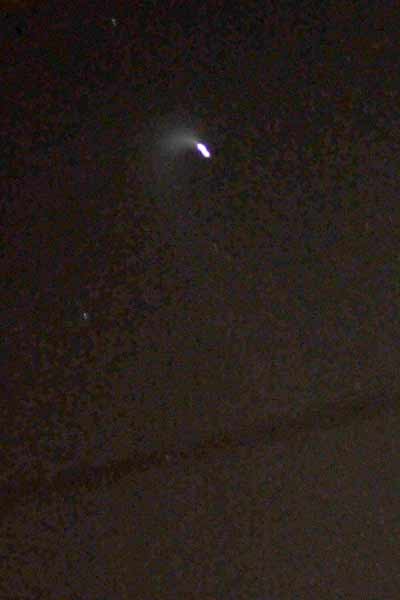Mystery Explained: Glow in Night Sky Was Astronaut Urine

The beautiful trail in the sky looked like a mysteriouscelestial event. In reality, it was urine.
Some skygazers were treated to the unexpected view of abright sparkling glow Wednesday night, created when astronauts aboard the spaceshuttle Discovery dumped the wasteout into space.
The water dump was a scheduled task for STS-128 pilot KevinFord, who poured out urineand waste water stored aboard the shuttle in preparation for a landingattempt Thursday. Weather thwarted that try, but astronauts plan anotherlanding attempt Friday at 5:48 p.m. EDT (2148 GMT) in Florida, though rain andhigh winds are expected again.
The light show Wednesday was aided by an unusuallylarge amount of water being dumped all at once - about 150 pounds (68 kg),said NASA spokeswoman Kylie Clem. Discovery had just undocked from theInternational Space Station the day before, and had not been able to unloadwaste water during the 10-day visit.
"It would have been a large quantity because we don?tdo water dumps while docked to the station now," Clem told SPACE.com in ane-mail. "That is a fairly new restriction over the last couple of flightsin order to prevent potential contamination of the Kibomodule."
The Kibo module is a new Japanese-built research lab on thespace station that includes an external platform to expose science experimentsto the space environment. Water dumps from a docked shuttle could potentiallypollute the experiments.
In general, though, spotting space water dumps from Earth iscommon, Clem said.
Breaking space news, the latest updates on rocket launches, skywatching events and more!
Waste water usually freezes upon jettison into a cloud oftiny ice droplets. Then when the sun hits, the ice sublimates directly intowater vapor and disperses in space.
A number of people in North America apparently spottedWednesday's dump, and some sent pictures to the Web site SpaceWeather.com.
One of them, Abe Megahed, photographed the tail at 9:40 p.m.EDT (0140 GMT) Wednesday from Madison, Wisconsin.
"I just watched theshuttle and station flyover (8:40 PM CST 9/9/09) and was surprised to see thatthe shuttle was sporting a massive curved plume," he wrote. "Whatcould it be? Something venting? An OMS burn? RCS thrusters? A massive, recordbreaking urine dump?"
It turns out he wasn't wrongabout that last one.
- New Video - Tour the Space Station's Bathroom
- Video - Drinking Water From Space Urine
- New Show - Inside the International Space Station

Clara Moskowitz is a science and space writer who joined the Space.com team in 2008 and served as Assistant Managing Editor from 2011 to 2013. Clara has a bachelor's degree in astronomy and physics from Wesleyan University, and a graduate certificate in science writing from the University of California, Santa Cruz. She covers everything from astronomy to human spaceflight and once aced a NASTAR suborbital spaceflight training program for space missions. Clara is currently Associate Editor of Scientific American. To see her latest project is, follow Clara on Twitter.
